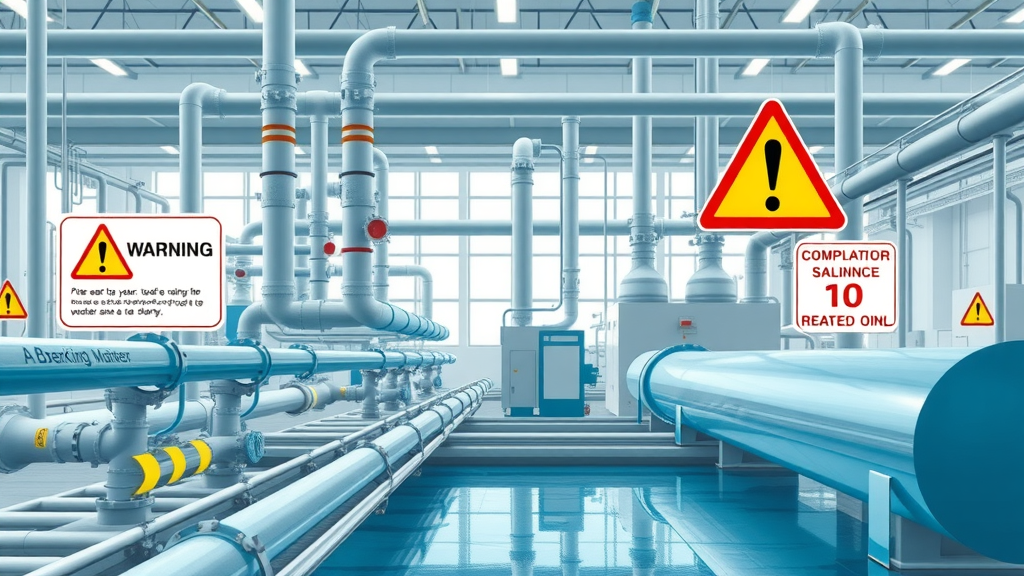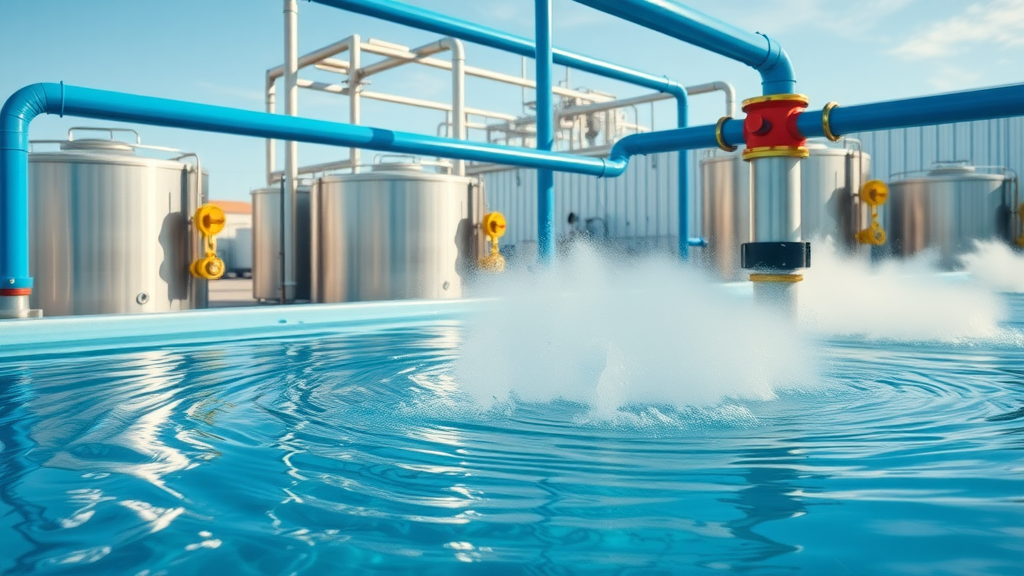Did you know that failing to meet industrial wastewater discharge limits can lead not only to steep fines but also public exposure and potential shutdowns? Industrial facilities face increasing scrutiny under stringent regulations targeting wastewater compliance issues. Understanding these industrial wastewater compliance FAQs is critical for plant managers and Environmental Health & Safety (EHS) professionals eager to stay ahead of regulatory challenges and protect their operations.
In this detailed guide, we unravel the complex regulatory framework, explore common causes of non-compliance, and outline actionable solutions — all supported by expert insights from Steve Manii of CSI Environmental, Inc.. Whether you’re managing sulfide levels, Total Suspended Solids (TSS), Chemical Oxygen Demand (COD), or Biological Oxygen Demand (BOD), this article will answer your pressing questions and empower you to achieve sustainable compliance.

Startling Facts About Industrial Wastewater Compliance
Many industrial plants underestimate how dynamic and variable wastewater compliance can be. The Clean Water Act sets a federal baseline, but local authorities such as Los Angeles County or Riverside County often implement far more stringent discharge limits. This means that for businesses operating in these areas, meeting federal requirements is not enough — you must continuously monitor and adapt to tighter regional standards.
Failing to meet compliance for parameters like fats, oils, and grease (FOG), sulfides, or pH levels can lead to a cascading enforcement process. Initial non-compliance results in written warnings from regulators, followed by required action plans and retesting. If issues persist, facilities may face hefty fines, public disclosure in newspapers, and in severe cases, forced shutdowns.
Given the complexity and potential consequences, understanding the nuances of wastewater compliance is vital. As Steve Manii points out, “The federal mandate is the baseline, but counties like LA and Riverside can set more stringent levels, making compliance a dynamic challenge for industries.”
Overview of Industrial Wastewater Compliance and Regulatory Framework
Steve Manii of CSI Environmental explains, "The federal mandate is the baseline, but counties like LA and Riverside can set more stringent levels, making compliance a dynamic challenge for industries."
The regulatory framework governing industrial wastewater discharge is layered and multifaceted. The federal Clean Water Act provides the foundation, mandating that facilities limit pollutants entering municipal sewer systems and surface waters. However, states and municipalities can enforce supplementary requirements above this baseline to protect local water quality.
Typically, composite or grab samples are taken monthly or semi-monthly by local water districts to analyze wastewater quality. This data is cross-checked with facility discharge permits defining acceptable levels for specific pollutants. Key parameters monitored include:
Key Parameters in Industrial Wastewater Discharge
Fats, Oils, and Grease (FOG)
Chemical Oxygen Demand (COD)
Biological Oxygen Demand (BOD)
Total Suspended Solids (TSS)
pH Levels (typically between 6 to 10)

Facilities must ensure these limits are consistently met, and any deviations must be promptly addressed to avoid enforcement actions. This constant vigilance underpins effective environmental protection and operational sustainability in the industrial sector.
Step-by-Step Process After Receiving a Compliance Notice
According to Steve Manii, "If sulfide levels exceed permit limits due to activities like deep tank cleaning, businesses must explain the anomaly and demonstrate corrective measures to pass retesting."
When a facility receives notification of non-compliance, the regulatory process unfolds systematically. Initially, local authorities perform a 24-hour composite sample to detect potential violations. If results exceed permit thresholds — for parameters such as sulfides, pH, or suspended solids — a formal written warning is issued to the responsible party identified on the discharge permit.
This notice details the nature of the violation and requires an action plan. Facilities must investigate the cause — for example, sulfide spikes caused by unusual activities like deep tank cleaning — and communicate this to regulators with a proposed remedy. Often, a retest follows to confirm improvement and restore compliance.
Common Causes of Non-Compliance
Excess sulfides
High TSS, COD, or BOD levels
pH outside permitted range

Failing to resolve these issues within the prescribed period triggers escalated enforcement. This includes increasingly stringent notices, fines, and potential operational shutdowns until problems are rectified.
Industrial Wastewater Treatment Solutions to Achieve Compliance
Steve Manii of CSI Environmental states, "We consult with businesses to implement cost-effective solutions like oxidizer injection and advanced treatment systems to meet permit requirements."
Successful industrial wastewater compliance often depends on effective treatment technologies. CSI Environmental offers expert consultation to help facilities identify and install appropriate treatment methods tailored to specific compliance challenges.
For sulfide control, methods such as injecting 12.5% chlorine or hydrogen peroxide into effluent lines neutralize harmful compounds before discharge. Addressing elevated Total Suspended Solids (TSS), COD, and BOD often requires incorporating mechanical or chemical treatment systems designed to reduce pollutant loads efficiently.
Role of Wastewater Treatment and Management Systems

Robust wastewater management not only prevents regulatory violations but can also yield operational cost savings. Many CSI Environmental clients report reductions of 90% or more in TSS and significant cuts in COD/BOD levels with proper treatment. These improvements translate into lower surcharge fees and enhanced sustainability.
Who Typically Receives Compliance Notifications Within a Company?
Compliance notices generally reach the individual listed on the industrial wastewater discharge permit. Job titles vary but commonly include Environmental Health and Safety (EHS) managers or supervisors, maintenance supervisors overseeing wastewater systems, or plant managers. Depending on company structure, multiple departments may be involved in compliance management.
Ensuring timely and clear communication internally is crucial to respond promptly to compliance issues and coordinate corrective actions.
Consequences of Non-Compliance and Enforcement Actions
Ignoring compliance warnings can escalate penalties quickly. Beyond fines, regulatory bodies have the authority to order operational shutdowns until violations are remedied. Public disclosure is another severe repercussion; for example, the Los Angeles County Sanitation District publishes listings of non-compliant facilities in major outlets like the LA Times, adversely impacting corporate reputation.
Public Disclosure and Its Impact

Such public exposure pressures companies to prioritize compliance proactively. It also motivates investment in advanced treatment solutions and expert guidance to avoid reputational damage alongside financial penalties.
How CSI Environmental Supports Businesses with Compliance
Steve Manii explains, "We act as a third-party liaison with regulatory bodies, helping businesses navigate complex wastewater compliance requirements effectively."
CSI Environmental's role extends beyond consulting to acting as a bridge between industrial clients and regulatory agencies. With established relationships across Southern California’s enforcement bodies, they facilitate clearer communication, advocate for clients, and deliver tailored compliance strategies.
Documentation Required for Compliance Assessment
Third-party lab reports from the last 3 to 6 months
Written compliance notices from regulatory agencies
Surcharge statements detailing TSS, COD, BOD charges
Permit discharge limits and related documentation


Cost Savings and Efficiency Benefits of Compliance
Meeting industrial wastewater compliance not only avoids fines but also improves operational efficiency. Reduced pollutant concentrations often lead to lower utility and chemical costs, fewer surcharge fees, and enhanced sustainability metrics. Many clients achieve up to 90-95% reduction in TSS and substantial COD/BOD decreases through targeted treatments, underscoring compliance as a competitive advantage.
People Also Ask: Industrial Wastewater Compliance FAQs
What are the three major safety concerns in the wastewater treatment industry?
Key safety concerns include exposure to hazardous chemicals, biological pathogens in wastewater, and risks associated with confined space or mechanical equipment during treatment operations.
What is wastewater compliance?
Wastewater compliance refers to meeting all regulatory requirements set by authorities regarding pollutant limits, discharge permits, monitoring, reporting, and treatment standards to protect environmental and public health.
What law allowed the EPA to establish wastewater standards?
The Clean Water Act (CWA) is the foundational federal law empowering the U.S. Environmental Protection Agency (EPA) to set wastewater discharge standards and regulate pollutant emissions into waters.
What are the three types of industrial wastewater treatment?
Treatment types include physical processes (screening, sedimentation), chemical treatment (oxidation, pH adjustment), and biological treatment (microbial degradation) used singly or in combination to meet discharge limits.
Animated explainer video of the industrial wastewater compliance process for plant managers and EHS professionals, illustrating sampling, enforcement, and treatment technologies.
Key Takeaways
Industrial wastewater compliance is governed by an evolving framework of federal, state, and local regulations demanding vigilance.
Non-compliance triggers a structured enforcement process including warnings, mandated action plans, retesting, fines, and possible shutdowns.
Effective treatment and wastewater management systems are critical to meeting discharge limits consistently.
Expert consultation, such as that from Steve Manii of CSI Environmental, can streamline compliance efforts and provide strategic solutions.
Proper documentation and proactive communication with regulators reduce risks and optimize operational costs.
Conclusion: Ensuring Industrial Wastewater Compliance for Sustainable Operations
Take proactive steps today to understand your compliance status, document thoroughly, and consult with experts like Steve Manii at CSI Environmental to prevent enforcement headaches and ensure sustainable industrial operations.
Get Your FREE Compliance Assessment Today
Don’t wait for regulators to find your compliance issues. Get your free compliance assessment or call (800) 690-2436 now for expert guidance tailored to your facility’s needs.
Understanding industrial wastewater compliance is crucial for plant managers and Environmental Health & Safety (EHS) professionals to navigate the complex regulatory landscape effectively. The U.S. Environmental Protection Agency (EPA) provides comprehensive resources on this topic. Their page titled “Industrial Wastewater” offers an overview of the National Pollutant Discharge Elimination System (NPDES) permitting program, which sets discharge limits and conditions for industrial and commercial sources based on the type of facility or activity generating the discharge. This resource is invaluable for understanding the federal framework governing industrial wastewater discharges. (epa.gov)
Additionally, the EPA’s “Industrial Effluent Guidelines” page details national standards for industrial wastewater discharges to surface waters and publicly owned treatment works. These guidelines are technology-based and cover over 50 different categories of industrial and commercial activity, providing specific limitations and standards that facilities must adhere to. (epa.gov)
For those seeking practical advice on maintaining compliance, Anguil Environmental Systems, Inc. offers an article titled “Challenges with Industrial Wastewater Compliance.” This resource discusses common factors leading to non-compliance, such as changes in industrial operations, lack of maintenance, and adapting to regulatory changes. It also provides insights into balancing EPA standards with environmental, social, and governance (ESG) commitments. (anguil.com)
By exploring these resources, plant managers and EHS professionals can gain a comprehensive understanding of industrial wastewater compliance, from federal regulations to practical challenges and solutions.
 Add Row
Add Row  Add
Add 




Write A Comment